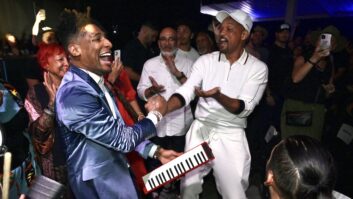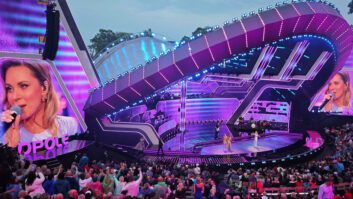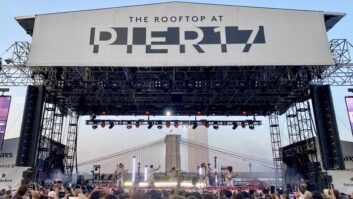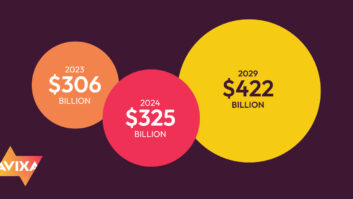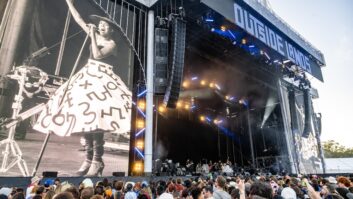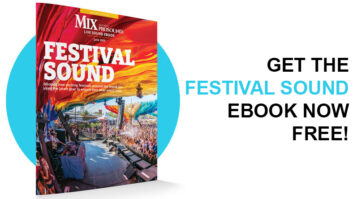Kraftwerk’s unique 3D-augmented performances were a highlight of Moogfest 2014
Asheville, NC (June 19, 2014)—I was lucky enough to attend this year’s Moogfest and found, not surprisingly, it was certainly a different kind of festival. The Asheville, North Carolina-based event, now spanning five days and 10 venues, has celebrated the legacy of Dr. Bob Moog—electronic music pioneer, inventor of the Moog synthesizer and founder of Moog Music—since 2004.

After a decade, Moogfest has manifested itself in an amalgamation of many things forward thinking and creative; it’s truly “the synthesis of technology, art and music,” to quote Moogfest’s own slogan. Daytime events mix performances with artist, engineer, and (yes) scientist-provided keynotes, panels, installations, workshops and films; nighttime events more closely resemble a traditional music festival, but one of otherworldly soundscapes, spread throughout a beautifully bohemian small city in the Blue Ridge Mountains. Personally, I enjoyed it immensely, from the performances of iconic electronic music artists to the prophetic waxing of instrument builders to even a world-renowned futurist (Jerome C. Glenn) who delivered one of several keynote addresses.
“Clearly the idea was to bring together scientists,” explains Gordon Reid, moderator of Moogfest 2014’s Synthesized Sounds & Voices panel series and, by trade, CEDAR Audio Ltd.’s managing director. “Mathematicians, physicists and other academics were there along with musicians, artists and dreamers. All together, they created a forum to interact. It brought together the art, the technology and its use, and future speculation to one place. It allowed people to not just hear what was being done today, but to discuss future directions of primarily electronic music and how it interacts with other art forms, and how technologies develop to make that possible.”
On Stage
Artists featured at Moogfest 2014 included dozens of electronic musical acts, including Kraftwerk, Keith Emerson, Chic featuring Nile Rodgers, Pet Shop Boys and M.I.A., with dozens of lesser-known, but equally envelope-pushing artists, too, spread throughout venues across town. Livonia, MI-based Thunder Audio was the primary sound provider; some nighttime events were covered sonically by the independent local venues that hosted them, such as Asheville’s legendary Orange Peel Social Aid & Pleasure Club.
“It’s a multi-venue festival, versus one or two stages at an outdoor festival,” explains Greg Snyder, business development manager for Thunder Audio. “Our biggest challenge? This isn’t just a music festival. It’s about technology and analyzing the art of music with evening concerts. The biggest challenges were designing systems around both musical and corporate applications, and meeting the riders of all the various artists, as some carried gear, some were on fly dates and some others needed everything. We facilitated all that from the audio perspective. It was quite a large team for Paxahau—artist curator for Moogfest 2014—looking at lighting, sound, staging, and video.”
Thunder Audio’s latest flagship system—a new L-Acoustics K2 rig—resided in the festival’s largest venue, the 2,431-seat Thomas Wolfe Auditorium, where Kraftwerk performed stunning multi-night 3D performances. The K2 system featured left and right arrays of nine K2, eight SB28 subs and three Arcs II out-fills, per side. Two K2 and two K1-SB subs per side were utilized as side fills, and six Kara enclosures provided front-fill. Power and processing came via LA-Rak touring racks with three LA8 amplified controllers.
“It’s probably number two or number three in the country,” offers Snyder on Thunder’s K2 system. “The K1 is famous for its dual 15s, and the K2 is smaller, based on dual 12s; we’d been using it for theater work in Detroit. This was the first time we’d been able to deploy it with something like Kraftwerk and in an electronic music festival situation.”
Between such venues as Asheville’s Diana Wortham Theater and downtown Masonic Temple, challenges abounded for the sound team; from the demands of working in the latter century-old, plaster-walled building to juggling multi-format programming, secondary audio systems for Moogfest 2014 were chosen carefully. “Not only were we thinking about what the artist needed or what an event required, we were thinking about acoustics and logistics,” tells Snyder. “At Masonic, the chosen systems were lighter-weight sound systems. One rig was basically ‘speakers on sticks,’ so to speak, and the other was our Nexo Alpha—groundstacked versus flown. We picked the Nexo system for its flexibility, coverage and groundstack-ability. Then there was Wortham, an auditorium where we’d normally fly, but couldn’t; because it’s an older venue, we were forced to ground-stack. The acoustics there required a system that would be flexible and full-frequency enough to do something like Keith Emerson—the full range that a Moog synthesizer can do, which is incredibly broad, frequency-wise. So we chose our JBL VTX, a four-way system that could be ground-stacked with acoustic values meeting our needs frequency-wise as well as ‘corporately.’”
A Participatory Festival
Look no further than Moogfest’s arguably most popular, highly respected events on the calendar: MAKE Workshops, where festivalgoers could build their own Moog synth from scratch. “They were all sold out,” explained Reid. “People were presented with circuit boards, cases and other bits and pieces. It wasn’t a clip-together kit; it really was ‘build your own synthesizer’ with a soldering kit. At the end of it, those participating could hold a small, self-built Moog synthesizer in their hands. It was a great educational experience.”
Educational opportunities extended beyond workshops and panels, as they were built into nighttime musical events, too. Engineer Nick Tipp—hired to head recording production duties for Moogfest 2014 via CyKiK, the festival’s programming curator—led a team of 47 volunteer college students that were eager to learn and participate. “The 47 were college students from UNC-Asheville University and Montreat College, both local schools with a recording/engineering program,” explains Tipp. “Four months before the festival, I knew I would need a lot of recording engineers. With this iteration of Moogfest being a different thing—with so much ‘future-thought’ daytime programming and all the music reflecting what Moog means as a brand—I knew that I’d need help; we did not have much of a budget to do it this time around. CyKiK, the company that hired me, were responsible for documentation of video and audio for the whole festival and felt it was important to capture everything.”
This need turned into an ideal teaching opportunity. “I reached out to the schools and spoke with them about a partnership,” tells Tipp. “Turns out, students did nearly all the recording. A fellow from Avid did the main stage and I gave him an assistant, but professors and students recorded all others. It was quite a feat organizing all these folks, but I had two great partners: Jude Weinberg from UNC-A and Kevin Allman from Montreat.” For all the main stages, a MADI-based recording rig was employed featuring a Behringer X32 digital console and DirectOut Technologies ANDIAMO 32-channel mic preamp with AD/DA converter. “There was a third-of-a-million-dollars worth of sponsored gear there from Sennheiser, Behringer, Avid, DirectOut Technologies and JoeCo; the latter provided all backup recorders. The gear was tracked throughout the city as the events went on. Surprisingly enough, we got every single piece back, down to Thunderbolt adapters! It was really great and the kids did an awesome job.”
The 47 volunteers fit well into Bob Moog’s lifelong philosophy, explains Tipp. “There’s this concept about Bob Moog. He learned, and was a student, his whole life. The culture of the festival and the people that attended the festival are about exploring new things—what’s on the bleeding edge of music and art intersecting technologies. The person that went to the festival, the average attendee, was a thinker. They were there to learn and absorb, rather than party.”
Local Involvement
Nearly everyone I spoke with at Moogfest 2014 had something kind to say about the host city, Asheville, with the general consensus being that this community was thrilled to host such a crowd of tech/art aficionados. “Residents of Asheville and shop owners wanted to talk about the festival,” recalls Tipp. “They wanted to learn about what I was doing and more about the daytime events. It seemed obvious to me, and from Moog’s own culture, that the purpose of the festival is to bring attention and business to Asheville. Something that directly engages thinkers and entrepreneurs, not just concert goers, will inspire people to come to Asheville again.”
“I think the environment added greatly to the experience,” says Reid. “Moogfest in an industrial, drab city may have had all of the same events and people, but it wouldn’t have had the same flavor. I love Asheville mostly because of the friendliness and the welcoming nature of the people. Then add the environment, as you’re surrounded by beautiful mountains on all sides, which naturally added to the happiness and goodwill apparent all around.”
Thunder Audio
Thunderaudioinc.com

